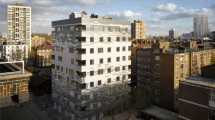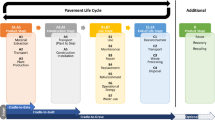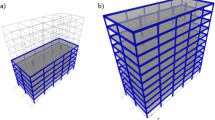Abstract
Compared to steel and concrete, wood offers a fully renewable construction material with lesser carbon footprint and high strength-to-weight ratio. However, this material has become relatively unknown and ignored in the civil engineering community apart from cosmetic purpose. This study intends to provide insight on the design of a timber bridge for road traffic and presents the results of a series of full-scale laboratory test and monitoring performed conducted on Hanareum bridge, the first timber bridge for road traffic constructed in Korea. The arched truss bridge is made of glulam and spans over 30 m with two traffic lanes for a width of 8.4 m. The laboratory test considered tensile, compressive as well as bending tests on full-scale members, connections and the entire superstructure. Truck load testing involved both static and dynamic loading from which the dynamic properties and behavior of the bridge could be assessed. Finally, regular monitoring enabled to observe eventual seasonal variation of wood. The analysis of the results show that the structure continues to behave elastically as desired, that the maximum deflection at mid-span reaches merely 24% of the allowable deflection, and that the stress level remains far below the allowances even after 6 years of operation.
Similar content being viewed by others
References
AASHTO (2017) Bridge design specifications. American Association of State Highway and Transportation Officials, Washington DC, USA
AF&PA (2005) National design specification for wood construction ASD/LRFD. American Forest & Paper Association, Inc., Washington DC, USA
AIK (2005) Korea building code. Architectural Institute of Korea, Seoul, Korea
AIK (2008) Design manual for timber structure. Architectural Institute of Korea, Seoul, Korea
Caceido JM, Dyke SJ, Johnson EA (2004) Natural excitation technique and eigensystem realization algorithm for phase I of the IASC-ASCE benchmark problem: Simulated data. Journal of Engineering Mechanics 130(1):49–60, DOI: https://doi.org/10.1061/(ASCE)0733-9399(2004)130:1(49)
CEN (2004) Eurocode 5: Design of timber structures (EN 1995-2). European Committee for Standardization
Di Schino A (2019) Environmental impact of steel industry. In: Hussain C (eds) Handbook of environment materials management. Springer, Cham, Switzerland, 2463–2483
Duan M, Perdikaris PC, Chen W (2000) Impact effect of moving vehicles. In: Chen WF, Duan L (eds) Bridge engineering handbook. CRC Press, Boca Raton, FL, USA
Jung HS (1998) Wood physics. Seoul National University Publication and Culture Center, Seoul, Korea, 178–182 (in Korean)
Jung H, Kim G, Park C (2013) Impact factors of bridges based on natural frequency for various superstructure types. KSCE Journal of Civil Engineering 17(3):458–464, DOI: https://doi.org/10.1007/s12205-013-1760-4
KCI (2007) Korea structural concrete design code commentary. Korea Concrete Institute, Seoul, Korea
Kim KH, Eom CD, Lee SJ (2012) Design, construction and evaluation of timber bridge for road traffic — Category 1 arch truss bridge with span length of 30 m. Research Report 12–18, Korea Forest Research Institute, Seoul, Korea (in Korean)
Kim KM, Shim KB, Kim BN (2010) Bending behavior of preservative treated pitch pine stress-laminated timber. Journal of Korean Wood Science and Technology 38(4):306–315, DOI: https://doi.org/10.5658/WOOD.2010.38.4.306 (in Korean)
KRTA (2010) Korea bridge design specification. Korea Road & Transportation Association, Seongnam, Korea
Lee J, Lim CH, Kim GS, Markandya A, Chowdhury S, Kim SJ, Lee WK, Son Y (2018) Economic viability of the national-scale forestation program: The case of success in the Republic of Korea. Ecosystem Services 29:40–46, DOI: https://doi.org/10.1016/j.ecoser.2017.11.001
Lee SJ, Shim KB, Kim KM, Kim S, Choi YS, Shin HK, Han Y, Park MJ (2016) Condition assessment of the first vehicular timber bridge in Korea. World conference on timber engineering (WCTE 2016), August 22–25, Vienna, Austria
Malo KA, Holmestad A, Larsen PK (2006) Fatigue strength of dowel joints in timber structures. Proceedings of 9th world conference on timber engineering (WCTE 2006), January, Portland, OR, USA
Michael MA (1990) Timber bridges — Design, construction, inspection, and maintenance. US Department of Agriculture, Washington DC, USA
Ramage MH, Burridge H, Busse-Wicher M, Fereday G, Reynolds T, Shah DU, Wu G, Yu L, Fleming P, Densley-Tingley D, Allwood J, Dupree P, Linden PF, Scherman O (2017) The wood from the trees: The use of timber in construction. Renewable and Sustainable Energy Reviews 68:333–359, DOI: https://doi.org/10.1016/j.rser.2016.09.107
Shim NH, Kim DK, Park YS (2012) An experimental study for structural evaluation of timber truss bridge. Korean Society of Civil Engineers Magazine 60(9):52–62 (in Korean)
Slivnik L (2013) Three-hinged structures in a historical perspective. In: Cruz PJS (ed) Structure and architecture: Concepts, applications and challenges. Taylor & Francis Group, London, UK, 1088–1095
UNFCCC (2003) Estimation, reporting and accounting of harvested wood products. Technical Paper FCCC/TP/2003/7, United Nations Framework Convention on Climate Change, Bonn, Germany
Yi J, Park W, Kim CY, Lee SJ, Koh HM (2013) Field load testing of the first vehicular timber bridge in Korea. Proceedings of 2nd international conference on timber bridges, September 30-October 2, Las Vegas, NV, USA
Acknowledgments
This work was supported by The Forest Science Research Program of Korea Forest Service.
Author information
Authors and Affiliations
Corresponding author
Rights and permissions
About this article
Cite this article
Yi, J., Park, J.H., Park, W. et al. Testing and Monitoring of the First Timber Bridge for Road Traffic in Korea. KSCE J Civ Eng 25, 2166–2174 (2021). https://doi.org/10.1007/s12205-021-1525-4
Received:
Revised:
Accepted:
Published:
Issue Date:
DOI: https://doi.org/10.1007/s12205-021-1525-4




